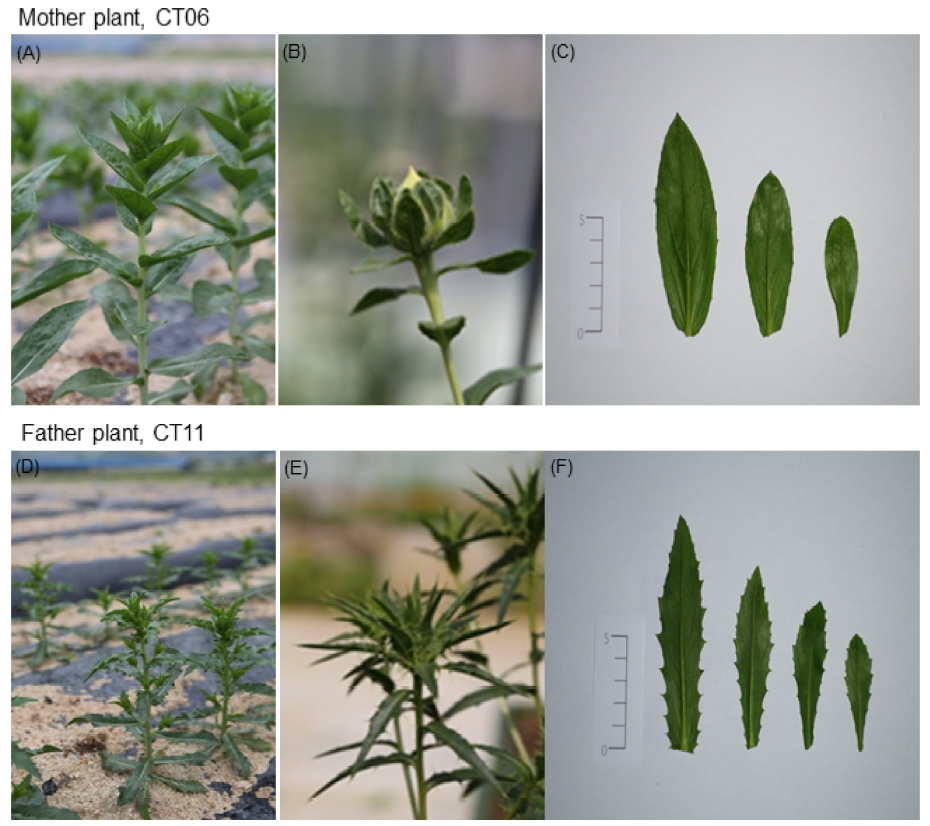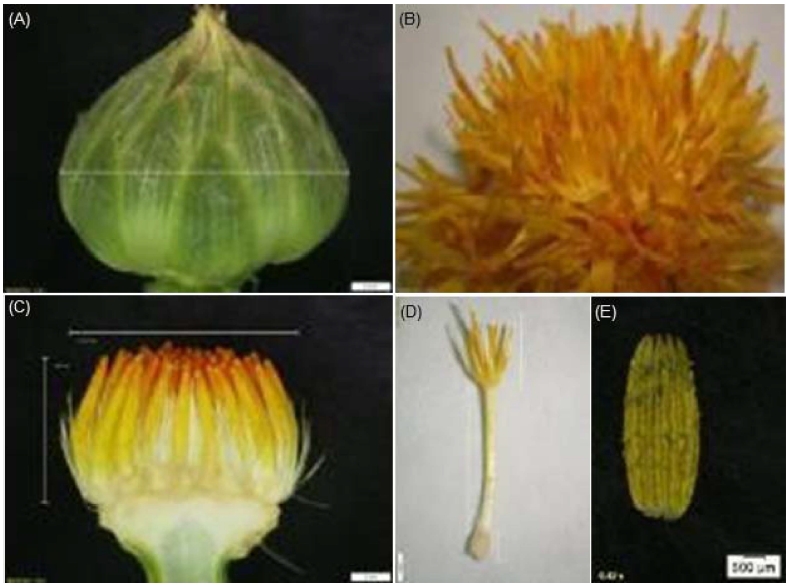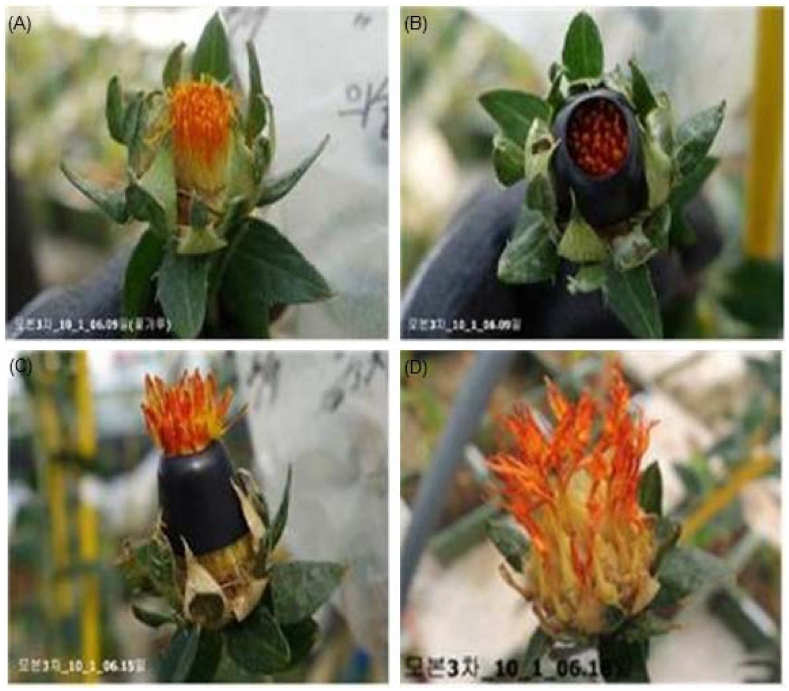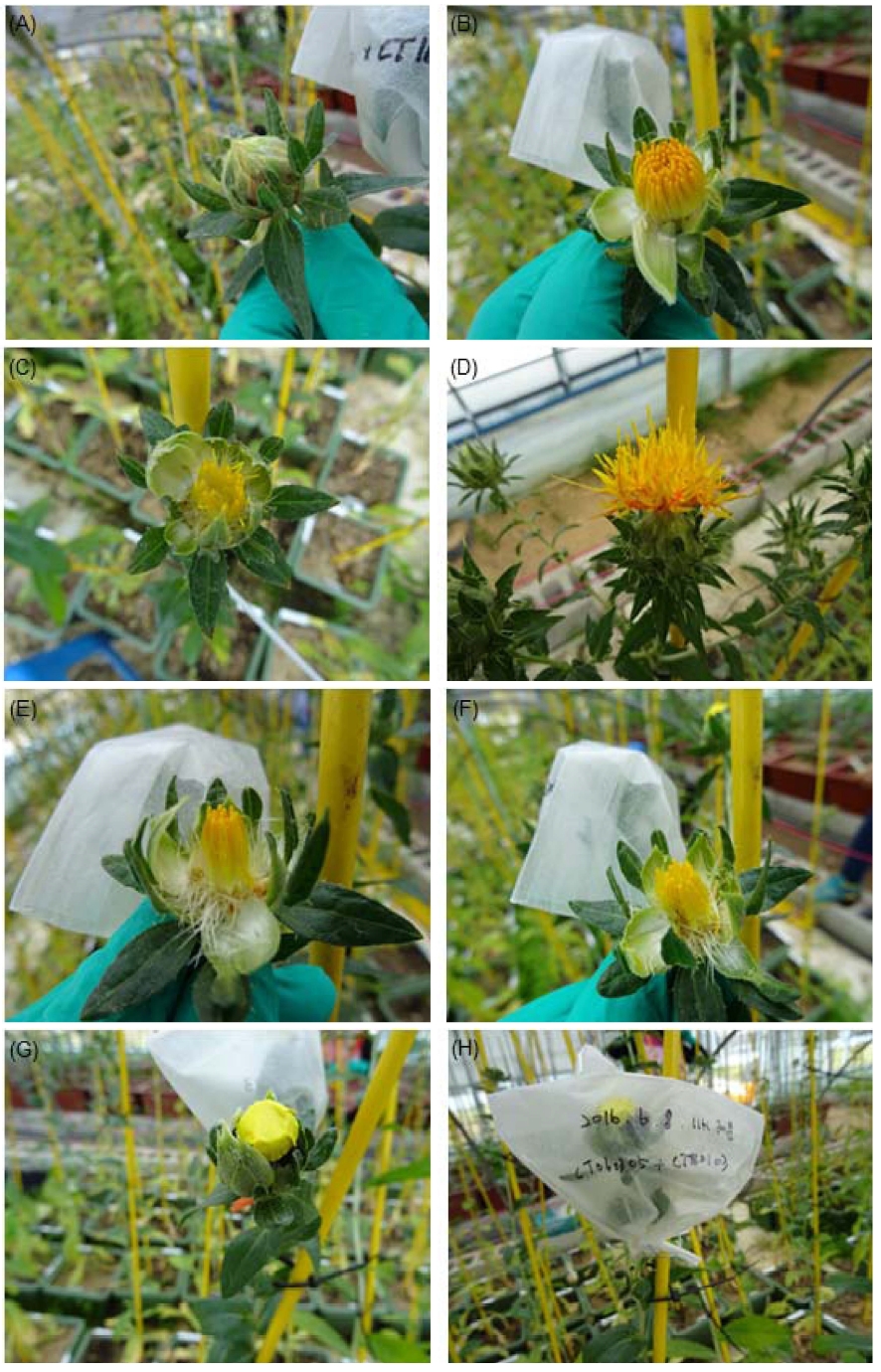
홍화 수집자원의 작물학적 특성 및 교배 방법
 ; Jeong Hoon Lee2, †
; Jeong Hoon Lee2, † ; Jin Tae Jeong3
; Jin Tae Jeong3 ; Jong Won Han4
; Jong Won Han4 ; Sang Hoon Lee5
; Sang Hoon Lee5 ; Kyung Ho Ma6
; Kyung Ho Ma6 ; Mok Hur7
; Mok Hur7 ; Jae Ki Chang8
; Jae Ki Chang8
This is an open access article distributed under the terms of the Creative Commons Attribution Non-Commercial License (http://creativecommons.org/licenses/by-nc/3.0/) which permits unrestricted non-commercial use, distribution, and reproduction in any medium, provided the original work is properly cited.
Abstract
Safflower (Carthamus tinctorius L.) is a useful medicinal and oil crop in Korea. However, when safflower is cultivated, the flowering period overlaps with the rainy season, and seed maturation is poor. Therefore, this study aimed to use basic research data to develop superior varieties using agronomic characteristics and crossing method.
A total of 34 safflower germplasms were sown and their agronomic characteristics were investigated. Based on these investigations, the cultivar ‘ui-san-hong-hwa’ was selected as the mother plant, and ‘Myanmar safflower’ (Hsu Pan) was selected as the father plant. In addition, we developed a floret-protecting cap to cover florets after emasculation during the artificial crossing. When florets were protected by the cap, the seed setting rate increased in comparison to that in the non-covered florets.
Agronomic characteristics can contribute to developing suitable varieties. The results suggest that the protection cap will be helpful in breeding without the floral organ drying. This study contributes an efficient breeding method to develop new safflower varieties.
Keywords:
Carthamus tinctorius, Artificial Cross, Floret Protection, Safflower서 언
홍화 (Safflower, Carthumus tinctorius L.)는 국화과에 속하는 1년생 초본식물로 한국, 중국 및 일본 등에서 꽃을 약용으로 재배하거나, 미국, 인도 등 여러 나라에서 유지작물로 널리 재배되고 있는 식물이다 (Park, 1998).
국내에서는 약용 및 유료 작물로서의 홍화 재배 역사는 오래되었으나 재배면적이 그리 크지 않다. 주로 경북 의성, 칠곡 등에서 극히 소면적 (24㏊)으로 재배되다가, 홍화의 약용으로서 가치가 널리 알려지면서 재배면적이 2 배 (55㏊, 129 ton) 정도로 증가하였다 (MAFRA, 2018). 그러나 취약한 가격 경쟁력으로 인하여 대부분 수입에 의존하고 있으며, 수입 홍화는 납, 비소 등의 중금속이 검출되어 보다 안전성이 높은 국내 토종 홍화 생산이 필요하다. 또한, 대부분의 농가에서 탄저병 등에 취약하며 생산성이 낮은 재래종을 재배하고 있으므로 우량품종의 육성보급이 요구된다 (Choi et al., 2003).
예로부터 홍화의 암술은 홍화 (紅花), 열매는 홍화자 (紅花子)라는 생약명으로 불리며, 천연염료, 식용유, 곡식, 한방 약제, 화장품 원료 등으로 다양하게 이용되고 있다 (Ahn and Chung, 2013). 한약재로서 홍화는 대한민국약전 (12 개정, 2020, MFDS)에서 기원식물을 C. tinctorius L.의 관상화로 규정하고 있으며, 주로 종자를 약용으로, 꽃은 적색 염료로 활용하고 있다.
홍화자 기름은 혈액순환, 해독 등의 작용 및 항콜레스테롤 기능이 있다고 알려졌으며, 동맥경화 및 지방질 유도 인슐린 저항성 예방에 효과적인 데다가, 건강기능성 소재 및 화장품 원료로서의 항산화 효과에 대해서도 보고되었다 (Cox et al., 1995; Zhang et al., 1996; Espín et al., 2000; Prescha et al., 2014). 꽃은 한방에서는 여성들의 통경약이나 무월경, 어혈에 의한 동통을 푸는 약재로 널리 이용하며, 종기 및 타박상 치료에도 효과가 있는 것으로 보고되고 있다 (Seo et al., 2000). 홍화 종자는 여러 가지 지방산을 함유하고 있는데 (Kim et al., 1996), 특히 불포화지방산인 linoleic acid의 함량이 높아 동맥경화, 고지혈증, 고혈압 등의 예방과 치료에 이용되고 있다 (Noh and Park, 1992).
최근 들어 홍화는 다양한 산업용 소재로 활용될 가능성을 제시하고 있으며, 특히 피부 개선효과가 있어 여드름 세안용 식물성 생약 비누 혹은 기초 화장품 소재로 응용될 수 있다 (Park and Lee, 2011). 또한, 기존의 화학 색소를 대체할 수 있는 우수한 천연 색소로서의 가능성을 평가받고 있다 (Kim et al., 2016).
국내 품종개발은 지자체의 약초 관련 연구소에서 청수 (1999), 의산 (2000), 진선 (2000) 및 화선 (2002) 등이 약용 및 식용 용도로 선발되었으나, 이들 선발된 홍화 품종은 주로 재래종이나 도입종 중에서 순계분리한 수준에 그쳤다. 한편, 홍화는 자식 (selfing)에 대한 유전적 잠재력이 90% 이상인 자가수분 작물로 (Dajue and Mundel, 1996), 인공교배 시 장마철과 개화기의 중첩, 수발아, 그로 인한 결실률 저하 등의 문제점이 있다. 또한 자식하여 품종 개발 시 변이 창출에 한계가 있으며 유전자 교환이 어려운 단점이 있다.
따라서 본 연구는 홍화 수집자원의 작물학적 특성과 교배연구를 통해 다양한 변이를 창출함으로써 우량한 품종을 개발하는데 기초 연구 자료로 활용하고자 수행하였다.
재료 및 방법
1. 실험재료
본 연구에 사용된 홍화 (Carthumus tinctorius L.)의 수집은 2013년 국립농업유전자원센터 (RDA, 전북 전주)에 자원들을 분양 요청하여 이루어졌으며, 주산지 및 약용작물 관련 지자체 연구소에서 수집되었다 (Table 1).
수집된 자원은 국립원예특작과학원 인삼특작부 시험포장 (충북 음성)에서 증식되었고, 증식 조건은 재식거리 30㎝ × 10 ㎝, 2 열 배열, 휴폭 90㎝ - 100㎝로 4월 상순에 직파하였다.
2. 작물학적 특성 평가
국내·외 홍화 수집자원 34 점을 지상부, 지하부 및 화기 구조 등의 특성평가를 실시하였다 (Table 2). 초장, 경경, 줄기색, 엽수, 엽장, 엽폭, 엽병장, 지상부 무게, 근장, 근경, 근중 등을 조사하였으며, 이를 바탕으로 교배에 필요한 모본과 부본으로 적합한 자원을 각각 선발하였다.
3. 교배 방법
교배 전 사전에 약의 열개 및 주두의 상황을 조사하였다. 개화 전 꽃봉오리의 화판을 열어 열개하지 않은 약을 핀셋으로 절개하여 제웅한 후 봉투를 씌어 소화를 보호하였다. 제웅 후 교배는 부본의 화분을 채취한 즉시 모본에 묻혀주었다.
4. 통계분석
실험 결과는 One-way ANOVA를 SAS Enterprise Guide 4.2 (Statistical Analysis System, 2009, Cray, NC, USA)로 분석하였고, 평균치 ± 표준오차로 나타내었다. 통계적 유의성은 Duncan's Multiple Range Test (DMRT)로 유의수준 5%에서 검증하였다 (p < 0.05).
결과 및 고찰
1. 홍화 수집자원의 작물학적 특성
홍화 (Carthumus tinctorius L.)의 교배대상 모본과 부본을 선정하기 위해, 분양받은 유전자원 34 점의 생육특성과 화기특성을 조사하였다. 지상부 생육특성의 경우, CT14, CT16, CT26 및 CT31 자원은 평균 초장이 90㎝ 이상이었고, 그에 반해 CT11 자원은 평균 초장이 50.33㎝로 가장 짧았다 (Table 3). CT29 등 7 자원은 지상부중이 200 g 이상으로 높았으며, CT05 자원은 평균 77.33 g으로 무게가 가장 적게 나갔다 (Table 3). 또한 이들 자원 중 CT34 자원의 경경 평균 17.93㎜로 가장 높게 나타났다 (Table 3). 지하부의 생육특성을 살펴본 바, CT10, CT34 등의 자원은 지하부중이 20 g 이상이었으며, 건물중은 CT16, CT29, CT30 등이 60 g 이상으로 높은 값으로 조사되었다 (Table 4).
수집자원의 화기특성을 비교하였을 때, 미얀마에서 수집된 CT11이 두화수가 가장 많았고, CT05의 두화수가 가장 적은 것으로 나타났다 (Table 5). 홍화자수는 CT02, CT03, CT08과 CT31 자원이 한 꽃 당 50 개 이상으로 다른 자원들에 비해 많은 것으로 나타났고, 또한 CT02, CT06 및 CT33은 한 주 당 종자 수량이 400 g 이상으로 다른 자원에 비해 상대적으로 높은 값을 보였다 (Table 5). 수집된 자원들은 평균 94.59%의 높은 발아율을 보였으며, 종자 발아적온은 15℃에서 20℃로 나타났다. 개화 시기는 CT06 자원이 6월 11일로 가장 이른 것으로 조사 되었다 (Table 5).
Park (2003)에 의하면 홍화의 초장은 조생종인 재래종에서 가장 짧고, 만생종인 수원 1호에서 가장 길었으나, 분지장은 만생종의 경우 조생종인 재래종보다 짧은 것으로 나타났다. Bang 등 (2001)은 홍화 수집종들의 생육특성을 비교하였는데, 홍화 자원들의 경장(莖長)을 조사한 결과, 12 개의 자원들이 단간종인 것으로 나타나 이들 자원들은 내도복성 품종 육성의 육종 소재로써 이용될 가능성이 있다 보고했다. 본 연구에서 CT11의 초장이 가장 짧았고 CT34의 경경이 가장 굵었는데, 이들 자원은 추후 내도복 자원으로 이용할 수 있음을 시사한다.
Park 등 (2004)은 홍화 수집종의 개화 소요 일수 조사에서, 국내종의 개화 소요 일수는 87 일에서 88 일인데 반해 중앙 아시아인 타지키스탄과 카자흐스탄에서 수집된 계통은 국내 자원보다 2 주 정도 개화기가 늦은 만생계통임이 밝혀졌다 (Park et al., 2004). 홍화의 개화기는 국내 수집 10 계통과 도입 6 계통 간 18 일의 차이를 보였으며 (Kim, 2000), Bang 등 (2001)도 홍화의 개화 소요 일수가 최저 74 일에서 최고 88 일까지 14 일의 변이를 나타낸다고 보고하였다. 이들 선행 연구는 34 점의 홍화 수집자원 간 개화일이 18 일 정도의 차이가 있다고 나타난 본 연구 결과와 비슷하였는데, 그 중 특히 중앙아시아 수집자원인 CT08, CT10, CT19 및 CT23은 개화가 늦은 특성을 보였다.
2. 홍화 육성집단 모·부본 선발
생육특성 평가를 바탕으로, 수집된 홍화 유전자원에서 모·부본을 선발하였다. 먼저 모본 선정 시 개화시기를 중요하게 고려하였다. 이는 홍화의 개화기는 6월 중하순으로 국내의 장마 시기와 겹쳐 탄저병의 발생이 많고 수정 장애에 의한 결실률 저하로 수량이 감소되며, 계통의 분지성이 낮아 수량 증대에 한계가 있기 때문이다 (Park et al., 2004). 또한 수확기의 강우로 인해 수발아 피해가 발생하기도 한다 (Kim et al., 2005).
홍화는 두상화로 개화기부터 성숙기까지 강우가 적으면 수정이 잘 안되고 결실 및 등숙이 불량해진다 (Bang et al., 2001). 농촌진흥청은 우량한 종실 생산을 위해 개화기를 장마기 이전으로 당기면 꽃봉우리 부패를 4% 이상 낮출 수 있으며 수량 감소율이 적었다고 보고하였다 (RDA, 1999). 따라서 교배를 통한 다수성 고품질 홍화 품종 육성 시, 이를 고려하여 조기 개화 특성 자원을 선발하는데 고려하였다.
화기특성 조사 결과, CT06 자원은 6월 상순에 개화가 시작하여 20 일 내에 90% 이상이 개화하였는데, 이는 수집 자원 중 가장 빠른 시기였다 (Table 5). 또한 개화 후 자방의 성숙이 20 일 내에 이루어져 장마기 전 많은 종자를 수확할 수 있는 우수 자원으로 평가되었다. 따라서 이를 바탕으로 개화 및 성숙이 빠르고 생육이 우수한 CT06 자원이 교배 모본으로 적합하다고 판단하였다. 선발된 모본은 경남 함양에서 수집·선발하여 육성한 의산홍화 (IT221709)로, 잎은 난상피침형 (anceolate)이고, 꽃은 황색이며 길고 가시가 많다. 또한 의산홍화는 줄기가 다소 가늘며 분지수가 많아 다수성이다.
곡실 수량 (grain yield)이 결정되는데 두화수 (capitula per plant)는 가장 중요한 형질로, 양의 상관관계이다 (Bagawan and Ravikumar, 2001). 홍화에서도 두화수는 가장 중요한 수량 구성 요소이며 (Ashri, 1971), 30 개국에서 수집된 홍화 자원의 13 가지 형태적 특성을 조사해본 바, 두상화수와 종실수가 다수성 홍화 계통 육성을 위한 가장 중요한 요인임이 밝혀졌다 (Ashri, 1973). 또한 Parameshwarappa (1981), Malleshappa (2000) 그리고 Bidgoli 등 (2001)의 선행연구에서도 두상화수와 종실 수량이 높은 상관관계를 가진다고 보고되었다. 이러한 점을 고려할 때, CT11의 두화수는 평균 37.7 개로 다른 수집 자원보다 상대적으로 많았으며, 이는 화분을 충분히 확보할 수 있다고 여겨지므로 부본으로 선발하기에 적합하다고 판단된다 (Table 5).
게다가 모본으로 선정된 CT06의 개화일수가 77.0 일인 것에 비하여 CT11의 개화일수는 82.5 일로 모본보다 5.5 일 지속되며, 이러한 점은 모본의 암술이 수정될 상태로 성숙하였을 때, 부본이 개화하여 화분을 암술머리에 묻혀주어 교배 성공률을 높일 수 있다. 위에서 언급했듯이, CT11의 초장은 50.33 ㎝로 가장 짧았고 줄기는 단간의 형태로서 수집자원들 중 가장 도복에 아주 강했다. 선발된 부본은 미얀마에서 수집된 미얀마홍화 (Hsu Pan, IT262778, 자원명: MMR-SJS-2011-11039)이며, 부본의 잎은 모본과 마찬가지로 난상피침형이나 잎과 화탁 등에 아주 강한 가시가 많이 있는 것이 특징이다.
이러한 결과를 바탕으로 개화시기가 빠른 CT06 (의산홍화)과 두화수가 많고 단간인 CT11 (미얀마홍화)을 각각 모본과 부본으로 최종 선발하였다 (Fig. 1, Table 6).

The overall safflower shape of mother (upper) and father (bottom) plant for selected cross.(A), (D); whole plant, (B), (E); flower appearance, and (C), (F); leaf shape.
3. 홍화의 화기 구조 특성 및 교배시기 규명
적정 교배시기를 규명하기에 앞서 현미경과 육안으로 홍화의 화기 구조를 관찰하고 임성이 있는 소화 (小花, floret)를 확인하였다 (Fig. 2).

Floral-organ structure of safflower.(A); inflorescence, (B); cleistogamous flower, (C); floret, (D); floret eliminated involucre, (E); stageman (anther generation).
국화과인 홍화는 설상화 (舌狀花)가 없는 관상화 (菅狀花)의 구조로 되어 있으며 (Fig. 2A), 파종 후 75 - 83 일 이후에 폐쇄화 (閉鎖花)의 형태인 소화가 형성되면서 자가수분을 유도한다고 알려져 있다 (Fig. 2B). 소화는 양성화로 끝이 5 개로 갈라지며 5 장이 합쳐진 합판화관 (合瓣花冠, sympetalous corolla)의 구조로 되어있다 (Fig. 2C). 수술은 약이 모여 통상을 이루는 취약웅예 (syngenesious)로 5 개의 수술이 화주를 둘러싸는 관상을 이루고 있다 (Fig. 2D, E).
모본인 CT06은 5월 하순에 두화가 형성되어 7 일 내에 90% 이상이 약이 발생하여 파종 후 82 일에서 90 일 이후 꽃가루를 형성하는데, 약 발생 후 암술이 성숙하면서 이미 발생한 수술의 약이 암술머리에 묻어 성숙되어 폐쇄화일 때 수정이 유도된다. 소화의 꽃잎은 초기엔 노란색을 띠다가 시간이 지날수록 붉은색으로 변하며, 꽃잎이 터지기 전 끝부분이 붉게 변할 때는 이미 약이 발생한 시기이므로 교배를 위해선 그 전에 제웅이 필요하다. 따라서 폐쇄화 상태에서 적정 시기에 꽃잎을 제거하고 수술을 제거함으로써 모본을 인공수분이 가능한 상태로 준비해야 한다.
인공교배 시 부본에서는 성숙한 화분의 충분한 채취가 요구되며, 모본은 약 (葯)이 열개하기 전에 화분 (花粉)을 제거한 후, 주두 (柱頭)의 성숙이 진행되어야 한다. 모본과 부본의 개화기가 일치할 경우 부본에서 성숙한 화분을 충분히 얻을 수 없으며, 모본은 약이 열개하여 자가수정이 이루어지게 된다. 따라서 모본보다 부본의 개화시기를 이르게 조절해 줌으로써 부본의 성숙한 화분을 채취하여 제웅이 된 모본의 주두에 인공수분을 실시할 수 있다. 이를 위해 파종시기를 달리하여 파종 후 개화시기를 조절하였다.
홍화에서 소화의 바깥 1 열에서 3 열은 수정이 매우 낮으므로 최대 3 열까지 제거 한 뒤 4 열부터 제웅 후에 교배하는 것이 유리하다. 다만, 제웅을 실시하기 위해선 총포 (總苞, involucre) 제거 후 꽃잎을 잘라 수술을 제거하는데, 이때 총포를 제거하게 되면 꽃잎의 수분 증발로 인한 건조로 자방의 성숙이 어렵게 된다. 그러므로 모본의 제웅 작업 후 총포를 대신해 외부로부터 소화를 보호하기 위한 캡 등이 필요하다. 따라서 본 연구에서는 소화 보호용 캡 (protecting cap)을 자체적으로 개발하였으며, 제웅 후에 캡을 씌워 암술의 성숙 과정에서 건조 및 피해를 방지하였다 (Fig. 3). 파종 후 64 - 71 일 사이가 인공교배의 최적기로 나타났으며, 제웅 후 소화 보호용 캡을 씌웠을 때 수정 및 결실률이 높아지는 것을 확인하였다 (Table 7).

Procedure of artificial cross in safflower mother parent.(A); emasculation, (B); floret protecting cap, (C); fertilization, (D); fruiting.
4. 홍화 교배 매뉴얼 개발
홍화는 자가수분작물로서 폐쇄화일 때 수분수정이 일어나므로 홍화집단을 교배하기 위해선 우선 총포를 제거해야 하여 제웅해야 하다. 홍화 교배율은 80%로 높았으나 보호캡을 씌우지 않을 경우 종자가 결실되지 않았다. 이러한 결과는 보호캡이 소화제웅 후 암술의 성숙과정에서 건조 및 피해를 방지하는 것으로 보인다. 이상의 결과를 Fig. 4와 같이 홍화 교배에 맞는 매뉴얼을 제시하였다.

Crossing manual of safflower.(A); Select the mother parent with immature pistil of cephalization, (B); Eliminate the 2 lines of floret after being carefully opened cover around mother parent flower with tweezers, (C); After removing 2 lines of cephalization and separating floret leaves, eliminate stamen, (D); Select the father parent matured stamen, (E); Coat the pollen uniformly on the mother parent to be crossed. Put pollen-embedded pistil into floret well, (F); Eliminate the non-crossed floret, (G); Cover the protection cap for pistil protection, (H); Put the mating envelopment made of parchment paper written cross combination and date of cross, and put it on the pin.
한편 홍화는 성공적인 교배를 위해 화분관을 제거하여 꽃을 제웅해 주어야 하며, 주두가 신장한 때에 제웅된 소화를 묻혀 주어야 하는데 이 과정은 일반적으로 꽤 시간이 걸린다. 인도의 Nimbkar Agricultural Reserch Institute에서 개발된 집단제웅 기술은 개개의 소화의 제웅에 시간이 덜 걸리며, 좀 더 효율적인 교배 종자를 생산할 수 있게 하지만, 이 집단 제웅 방법은 높은 온도에서는 효과가 떨어지며, 봉투 안에서 화분의 불임을 유발시키는 단점이 있다 (Deshmuk and Rao, 1989). Deshmuk와 Rao (1989)는 폴리에틸렌 백을 소화에 덮어준 반면, 본 연구에선 제웅을 끝낸 소화에 보호 캡을 씌워주었으며, 이로써 홍화 인공교배 시 결실률이 높아지는 효과를 얻을 수 있었다.
Acknowledgments
본 연구는 농촌진흥청 연구사업(과제번호: PJ014406032019)의 지원으로 수행된 결과로 이에 감사드립니다.
References
-
Ahn SH and Chung NJ. (2013). Morphological characteristics and function of hilum in safflower seed germination. Korean Journal of Horticultural Science and Technology. 31:117-122.
[https://doi.org/10.7235/hort.2013.12150]

-
Ashri A. (1971). Evaluation of the world collection of safflower, Carthamus tinctorius L. I. Reaction to several diseases and associations with morphological characters in Israel. Crop Science. 11:253-257.
[https://doi.org/10.2135/cropsci1971.0011183X001100020026x]

- Ashri A. (1973). Divergence and evolution in the safflower genus, Carthamus L.: Final Research Report. Hebrew University of Jerusalem. Rehovot. Israel. p.180.
- Bagawan I and Ravikumar RL. (2001). Strong undesirable linkages between seed yield and oil components-A problem in safflower improvement. Proceeding of the Vth International Safflower Conference. Fargo. ND, USA. p.103-107.
- Bang KH, Kim YG, Park HW, Seong NS, Cho JH, Park SI and Kim HS. (2001). Classification of safflower(Carthamus tinctorius L.) collections by agronomic characteristics. Korean Journal of Medicinal Crop Science. 9:301-309.
-
Bidgoli AM, Akbari GA, Mirhadi MJ, Zand E and Soufizadeh S. (2001). Path analysis of the relationships between seed yield and some morphological and phenological traits in safflower (Carthamus tinctorius L.). Euphyica. 148:261-268.
[https://doi.org/10.1007/s10681-005-9019-x]

- Choi BR, Cho EJ, Park KY, Lee HB, Lee ES and Kim YH. (2003). Disease resistant and high yielding new safflower variety “Jinsun”. Korean Journal of Medicinal Crop Science. 11:167-170.
- Cox C, Mann J, Sutherland W, Chisholm A and Skeaff M. (1995). Effects of coconut oil, butter, and safflower oil on lipids and lipoproteins in persons with moderately elevated cholesterol levels. Journal of Lipid Research. 36:1787-1795.
- Dajue L and Mundel HH. (1996). Safflower. Carthamus tinctorius L. Promoting the conversation and use of underutilized and neglected crops. Institute of Plant Genetics and Crop Plant Research, Gatersleben/International Plant Genetic Resources Institute. Rome, Italy. p.83.
- Deshmuk AK and Rao VR. (1989). A new and efficient method to achieve mass hybridization in safflower wit hout emasculation: A re-appraisal of currently followed emasculation techniques. In Rao VR and Ramachandran M. (ed.)., In Proceeding second international safflower conference Indian society of oilseeds research. Hyderabad, India. p.157-161.
-
Espín JC, Soler-Rivas C and Wichers HJ. (2000). Characterization of the total free radical scavenger capacity of vegetable oils and oil fractions using 2,2-diphenyl-1-picrylhydrazyl radical. Journal of Agricultural and Food Chemistry. 48:648-656.
[https://doi.org/10.1021/jf9908188]

- Kim JB, Cho MH, Hahn TR and Paik YS. (1996). Efficient purification and chemical structure identification of carthamin from Carthamus tinctorius. Agricultural Chemistry and Biotechnology. 39:501-505.
- Kim JC, Kim KJ and Choi SY. (2005). Effect of cultivation methods and harvesting time on yield and quality of safflower (Carthamus tinctorius L.) seeds. Korean Journal of Crop Science. 50:187-190.
- Kim JC. (2000). Major morphological characteristics of safflower (Carthamus tinctorius L.) accessions. Korean Journal of Plant Resources. 13:213-218.
- Kim JG, Choi OJ, Yun YH and Kim DW. (2016). Literature review of safflower(Carthamus tinctorius L.). The Journal of Applied Oriental Medicine. 16:63-68.
- Malleshappa SM. (2000). Evaluation of selected early generation progenies of safflower for yield and yield component characters. Master Thesis. University of Agricultural Sciences. Dharwad, India. p.55.
- Ministry of Agriculture, Food and Rural Affairs(MAFRA). (2018). Industrial crop production statistics. Ministry of Agriculture, Food and Rural Affairs. Sejong, Korea. p.8.
- Ministry of Food and Drug Safety(MFDS). (2020). The Korean Pharmacopoeia 12th. Ministry of Food and Drug Safety. Cheongju, Korea. p.129.
- Noh WS and Park JS. (1992). Lipid composition of Korean safflower seed. Journal of Korean Agricultural Chemical Society. 35:110-114.
- Parameshwarappa KG. (1981). Genetic analysis of oil, yield and other quantitative characters in safflower(Carthamus tinctorius). Ph. D. Thesis. University of Agricultural Sciences. Bangalore, India. p.108.
- Park GH, Jung DC, Kim JC, Jeon CH and Kim KM. (2004). Agronomic characteristics and path-coefficients of safflower (Carthamus tinctorius L.) collections. Korean Journal of Medicinal Crop Science. 12:17-23.
- Park JS. (1998). Extraction and analysis of carthamin contained in the safflower. Korean Journal of Plant Resources. 11:60-63.
- Park JS. (2003). Flowering habit and seed ripening patterns of safflower(Carthamus tinctoruis L.). The Journal of The Korean Society of International Agricuture. 15:111-118.
-
Park YH and Lee CS. (2011). Efficacy of safflower on the Acne skin and its application for facial cleansing biomedical material. Journal of the Korean Chemical Society. 55:400-404.
[https://doi.org/10.5012/jkcs.2011.55.3.400]

-
Prescha A, Grajzer M, Dehyk M and Grajeta H. (2014). The antioxidant activity and oxidative stability of cold-pressed oils. Journal of the American Oil Chemists’ Society. 91:1291-1301.
[https://doi.org/10.1007/s11746-014-2479-1]

- Rural Development Adminstration(RDA). (1999). Oil crop standard cultivation textbook. Rural Development Adminstration. Suwon, Korea. p.270-280.
- Seo HJ, Kim JH, Kwak DY, Jeon SM, Ku SK, Lee JH, Moon KD and Choi MS. (2000). The effects of safflower seed powder and its fraction on bone tissue in rib-fractured rats during the recovery. Korean Journal of Nutrition. 33:411-420.
-
Zhang H, Nagatsu A and Sakakibara J. (1996). Novel antioxidants from safflower(Carthamus tinctorius L.) oil cake. Chemical and Pharmaceutical Bulletin. 44:874-876.
[https://doi.org/10.1248/cpb.44.874]

